Marseille, port city, oldest in France after Paris, is vibrant and raw, with an influx of North African and Mediterranean immigrants that lend their own culture and identity to the city. It sprawls between the coast and the St. Victoire range, throbbing and pulsating and demanding to be noticed.
Avignon, on the other hand, is quiet and stoic, resting on its laurels and its history. Once the seat of the papacy, the town exudes charm and power, and even though the pope returned to Rome 600 years ago, Avignon still enjoys the wealth and prosperity it has experienced since the 14th century.
I spent two days in Marseille, being pushed and pulled by its ebb and flow. The wind and salt air made me miss living near the coast, and all the energy that sea life brings with it. I plodded along the coastal road, passing rocky outcrops and beaches that were surprisingly crowded despite the cool weather. No one was swimming or sunbathing, but it appears the beach is still the main draw even in late autumn.
I saw the major landmarks: the Vieux (Old) Port and the forts and castles meant to defend the city from invaders and outsiders, the harbor and all the sailboats at rest, the cathedrals which were at once imposing and welcoming. I also cruised the back streets, where the houses were brightly painted and passages narrow, and the Mediterranean sparkled in stolen glimpses down alleyways and past apartment buildings.
Marseille is dirty. There was dog crap everywhere, litter on the streets, graffiti on every surface. There were piles of ash on the pavement where garbage or refuse had apparently been burned. I saw city workers loading a charred mattress onto a truck. I even saw the people walking in front of me casually drop their wrappers onto the sidewalk. And yet, while I wished there were fewer things to step over, I didn’t find it offensive. The dirt and the grit seemed to fit with what was an unrestrained and evolving city—people’s lives were lived on those streets, so it seemed appropriate to find the vestiges of those lives on the street also.
While the streets weren’t prettified, the people were. Or rather, they seemed like most other people I had passed in most other French cities, albeit there was much more ethnic influence here. They dressed in the latest fashions and were perfectly coiffed and made up. They said “Pardon” if they bumped into you, and they said “Merci, au revoir” to the shopkeepers when they left, just like they do everywhere else in France. However, unlike everywhere else in France, people seemed a little less inhibited, and a little more vocal, and definitely more passionate. Street arguments were louder than they would have been in Paris, and I didn’t see passers-by casting disdainful glances over their shoulders as they would have in Aix-en-Provence.
I wandered back to my hostel after dark, a little worried since I had read that it was in a not-so-nice neighborhood. But my fears subsided as I was absorbed into the goings-on around me. Women wearing headscarves pushed baby carriages down the street and stopped at markets and bakeries to buy ingredients for the evening meal. Men gathered in shop doorways to smoke cigarettes and chat about the day. Friends met each other on the street with double-cheek kisses. I heard more Arabic in that one day than I have heard since I’ve been in France, even in the ethnic neighborhoods of Paris.
I made it out to the Chateau d’If, 16th-century fort, 17th-century prison, and infamous setting for Alexandre Dumas’ Count of Monte Cristo. I really enjoyed visiting the island and fortress—perhaps because it fed my imagination so well—but found that a little ironic, since I thought the book was so totally boring.
While Marseille throbbed, Avignon stood sedate. Surrounded by still-intact medieval walls, the old city is proud and serene, bathed in the glow of past importance. The papacy relocated here in the 1300s, when Clement V chose the city as his residence. It lasted in Avignon through 7 popes, each one adding onto the Palais des Papes until it was both impregnable and imposing.
Rather than inspiring piety, I found that the Palais des Papes boasted of power. Among the artifacts housed inside the castle were written indulgences, signed by the various pontiffs, and several ornate and impenetrable locks found on some of the interior doors. Many of the large rooms of the castle were devoted to the accounting and treasury of the church’s funds, and the smaller rooms dedicated to the sorts of behind-closed-door meetings now associated with CEOs and executive boards. Apparently, for the feast of the coronation of Clement VI, some 1000 sheep, 2000 geese, 7400 chickens and 95,000 loaves of bread were served. The Italian monarchs, though they were warring with each other, entreated each new pope to return to Italy, and it was no wonder. With the papacy, came prosperity and influence.
The Pont d’Avignon, also called the Pont St. Benezet, a bridge built in the 12th century but partially washed away by a flooding Rhone in the 17th, still stands as an example of medieval architecture. A shepherd boy who was told by angels to build a bridge across the Rhone, St. Benezet miraculously moved a huge stone to convince his supporters of his divine inspiration—and to get them to fund the project. There is also a nursery rhyme famous in France that’s all about dancing on the Pont d’Avignon. Though I don’t know the tune, just reading the lyrics was enough to get it stuck in my head for the rest of the day.
Avignon glows purple after dark. I don’t know if this has anything to do with the lavender of Provence or if the city planners just liked purple, but rather than just illuminating the castles and bridges and monuments, they are illuminated with purple light. It gives the city a regal bearing, and the monuments stand with authority, just as they did so many centuries ago.
Though only a few kilometers separate their geographic centers, the distance between Marseille and Avignon is immeasurable. And yet, despite their differences, both cities are characteristically French. A tale of two cities indeed.
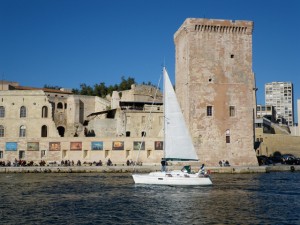
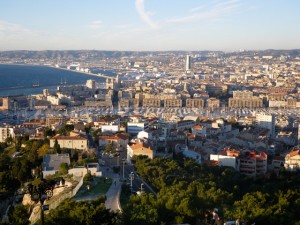
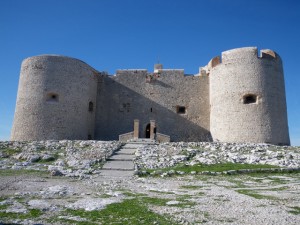
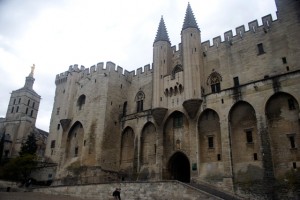
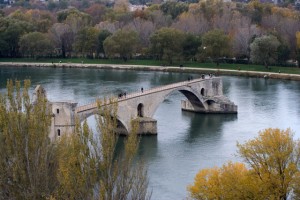

{ 1 comment… read it below or add one }
Beautiful photos and great descriptions – loved the lavender across the Rhone. My visit to Avignon was in 1991 – you have rustled up a few more of my distant memories.